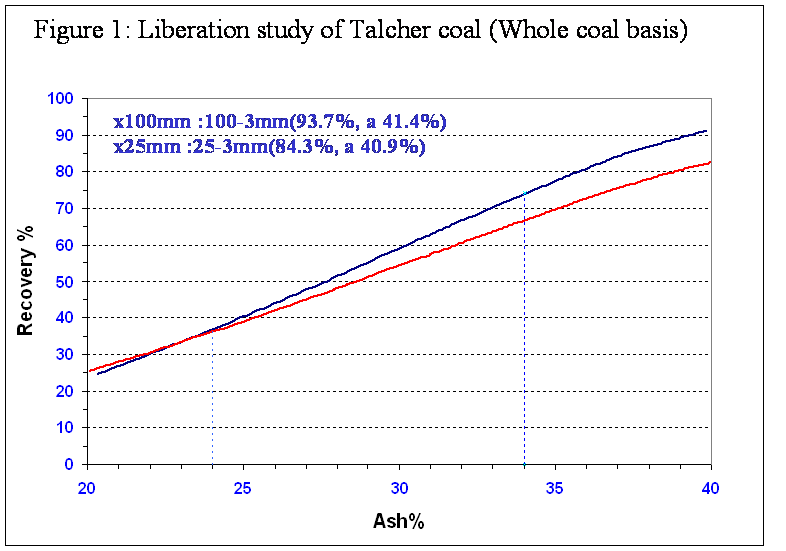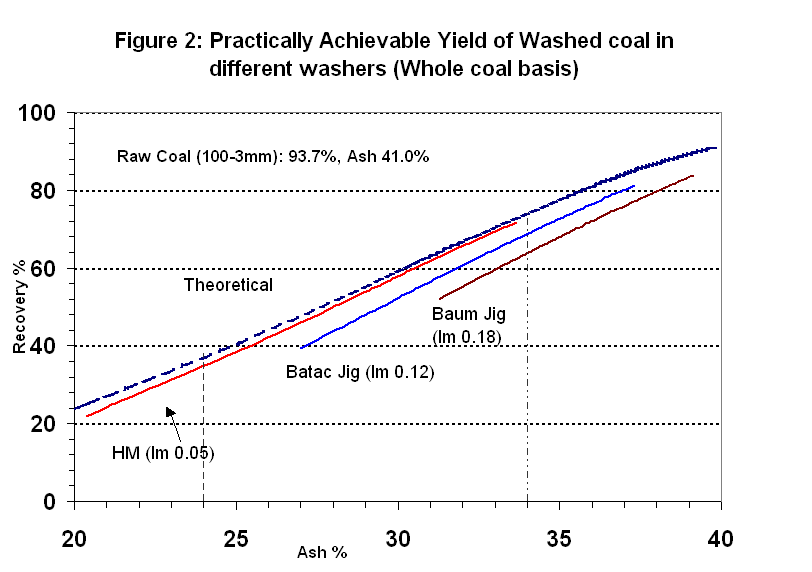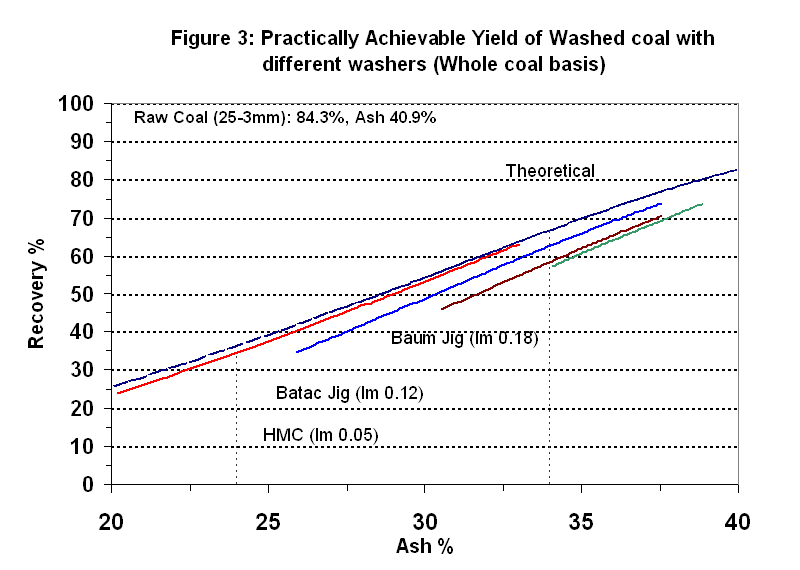kalyansen.com
dr kalyan sen
How to choose coal washers?
Choice of Washers for Cleaning of High Ash Indian Coals for Power, Cement and Sponge Iron Industries
Kalyan Sen
Emeritus Scientist,
Bengal Engineering and Science University,
Shibpur, Howrah
The Mining, Geological & Metallurgical Institute of India, Kolkata, Dec 2005
Introduction
The choice of washers for effective cleaning of high ash Indian Coals primarily depends on the Washability characteristics of the coals vis-à-vis need of the industry.
The present scenario requires thermal power plant feed to be prepared below 34% ash. The same for Cement plants varies from 30 to 32% ash and for Sponge iron industries below 28% ash.
Though there is no particle size restriction for pulverized coal fired plants, others prefer +6mm.
Moisture (total) in washed coal should be restricted to 8 to 12%, as seen in table nos 1,2 and 3.
Table 1
Coal quality requirements for Power Plants
Sl No |
Characteristics |
Requirement |
1 |
Total Moisture Content,% |
8 to 12 max |
2 |
Volatile Matter (air dry basis),% |
19 min |
3 |
Ash, %(annual average) |
34 max |
4 |
Sulfur, % |
0.8 max |
5 |
Chloride,% |
0.01 max |
6 |
Size, mm |
250 max |
Table 2
Coal Quality requirements for Cement Industry (IS 12770:1989)
Sl No |
Characteristics |
Requirement |
1 |
Total Moisture Content (at 60% RH and 40degree C),% |
8 max |
2 |
Volatile Matter (air dried),% |
24 min |
3 |
Ash,% |
27 max |
4 |
Sulfur,% |
0.8 max |
5 |
Chloride, % |
0.01 max |
6 |
Size, mm |
250 max |
Table 3
Coal Quality Requirement for Sponge Iron Industry
Sl No |
Characteristics |
Requirement |
1 |
Total Moisture Content |
6 max |
2 |
Grade & UHV, kCal/kg |
B/C, 4940-6200 |
3 |
Fixed Carbon,% |
42 min |
4 |
Volatile Matter (air dry), % |
30 min |
5 |
Ash, % |
22-25 |
6 |
Initial Deformation Temp. |
>1280 deg C |
7 |
Reactivity |
>1.7 cc of CO per g |
8 |
Size, mm |
-25+3 |
Source : OSI
Crushing Coal before or after Washing
Crushing raw coal to finer size before washing leads to more energy requirement, products de-watering and water effluent clarification problems than crushing the washed coal to the size required by the customer. For most of the difficult-to-wash non-coking coals of India crushing below 100mm may not lead to any significant liberation which can compensate the extra expenditure mentioned above.
As a case study, a Talcher coal having about 40% overall ash may be seen in table 4.
Table 4
Washability Characterization of Talcher Coal under study
Proximate Analysis
|
Air Dried |
Dry |
Equilibrated |
|
|
Moisture, % |
6.5 |
- |
4.7 |
IDT |
>1400 deg C |
Ash, % |
37.8 |
40.4 |
|
|
|
V.M.,% |
25.9 |
27.7 |
|
|
|
F.C. |
29.8 |
31.9 |
|
|
|
Size Analysis
ROM Coal Crushed to 100mm |
ROM Coal Crushed to 25mm |
||||
Size, mm |
Wt,% |
Ash,% |
Size, mm |
Wt, % |
Ash, % |
100-75 |
29.7 |
42.5 |
|
|
|
75-50 |
25.0 |
40.8 |
|
|
|
50-25 |
19.0 |
41.1 |
|
|
|
25-13 |
11.2 |
39.7 |
25-13 |
57.4 |
42,2 |
13-6 |
6.0 |
37.8 |
13-10 |
8.3 |
41.3 |
6-3 |
2.8 |
37.3 |
10-3 |
18.6 |
39.3 |
3-0.5 |
3.7 |
34.9 |
-3 |
15.7 |
38.8 |
-0.5 |
2.6 |
41.0 |
|
|
|
|
100.0 |
40.6 |
|
100.0 |
41 |
Source:CFRI
In this particular case, the coal was crushed to 100 and 25mm separately. As per requirement, +3mm fractions were only to be washed. It is seen that +3mm fractions in –100 and –25mm coal were 93.7 and 84.3%. Liberation characteristics are shown in Fig1.
It was obviously observed that at 34% washed coal ash, the theoretical yield (on whole coal basis) of +3mm fraction in –100 and –25mm coals were expected to be about 74 and 67% respectively.
Though it is strange to observe that the expected theoretical yield is reduced due to progressive crushing, it happens most of the time if the whole coal i.e. 100-0 and 25-0 mm is not considered for washing. In fact lot of coal remains unwashed as –3mm fraction in the above considered example, which was as much as 6.3 and 15.7% respectively.
Practical Beneficiation of Coal
As discussed earlier, there are several alternative techniques for washing coal. Most economical will be dry-deshaling of raw coals by Rotary Breakers. A properly designed and operated rotary breaker can hopefully reduce the ash down to 36-37% with the consequent loss of yield by 5 to 8 %. It may be techno-economically desirable to get rid of the hard obvious stones by dry-deshaling before further processing - be it crushing or washing.
There are several alternatives for washing –100 and –25mm coals. Baum and Batac jigs can be used. One can also use H.M. washers like H.M.Bath for coarser coals (+25mm) and H.M. Cyclones for –25mm coal fraction.
It is interesting to compare the expected practical results by use of these chosen alternatives. In all cases, normal performance values are considered for such comparisons.
It is seen that with normal performance efficiency values ( Im = 0.18) of Baum jigs, the expected yield at 34% ash is about 70% (on whole coal basis) in case of 100-3mm coal and 64% for 25-3mm coal. It is also interesting to note that Baum jigs can reduce ash down to 30% only, due to inherent design parameters e.g. Sp. Gr. of cut can not be reduced to below 1.65.
In a similar case, the Batac jigs ( Im = 0.12) can reduce washed coal ash down to as low as 26%. The expected practical yield will be hardly 40% in case of 100-3mm coal and 35% for 25-3mm coal. However, due to comparatively higher performance efficiency, at 34% ash the expected yield will be 5-6% higher in comparison to Baum jigs.
For deep coal washing the H.M. processes will be eminently suitable. The loss of yield due to inefficiency of the practical system may not be more than3 to 5 %. However, it should also be remembered that a H.M.Bath or Cyclone may be difficult to operate with media having Sp.Gr. more than 2.0, mainly due to viscosity of the media. Thus, it is seen that it may not be wise to run the H.M. circuit at very high gravity to produce the deshaling effect i.e. to produce washed coal with 34% ash. As expected, the H.M. circuit can produce deep cleaned washed coal having ash as low as 25% or even less. At 25 % ash the yield will be about 40% from 100-3 mm coal (Fig 2).
Fig 3 shows the expected yield from 25-3mm coal. Here also the H.M. Cyclone can produce deep washed coal with ash as low as 25 % with about 39% yield. In this case also it is seen that it may not be possible to operate the cyclone with Sp.Gr. of media more than 2.0. Thus, it will not be wise to try to run the cyclone to produce 34% ash i.e. deshaling effect.
Fig 3 also shows that Water only Cyclone (Im=0.2), can produce results slightly inferior to Baum Jig, and may not be able to reduce ash to below 34%.
Economical Aspect of Washing Processes
A key element in process selection is maximum recovery of the desired product from raw coal at lowest possible cost.
Technical selection of the process can be effectively made with the help of computer simulation as shown in the paper. It gives the complete range of operation and the expected yield and ash values .
Jigs using water only are always cheaper and ideally suitable for deshaling of Indian coals, but not for deep cleaning. They can be easily used for washing coal for power plants.
Heavy Media washing plants cost more to build and operate. However, their cleaning efficiency particularly for deep cleaning of coal is comparatively better than others and thus produce more yield of cleans. In comparison to Jigs, Water-only-cyclones or Hydro-separators, it can sometimes produce 6 to 8% extra cleans.
Conclusion
Washability characteristics of the raw coals should be the prime criteria in selecting the washing circuit.
Considering the poor liberation characteristics, high ash Indian non-coking coals should preferably be washed at larger size i.e. at –100mm size. The washed coal can be crushed to finer size, if desired.
Jigs and other water-only washers are sufficient for deshaling of raw coals and produce power plant grade washed coal i.e. down to 34% ash.
Heavy Media Baths and Cyclones are the most efficient separators for deep washing of high ash difficult-to-wash Indian Coals and be operated at wide range of gravity from 1.30 to 1.80, with minimum misplacement of cleans. Thus, requirement of low ash washed coal (around 25%ash) for Cement and Sponge Iron Industry can be met by Heavy Medium separators.


![]()
![]()

![]()
![]()
![]()

![]()